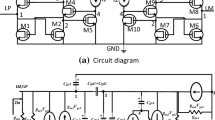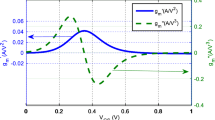Abstract
This paper presents the design of a high conversion gain and low flicker noise down conversion CMOS double balanced Gilbert cell mixer using \(0.18\,\upmu \hbox {m}\) CMOS technology. The high conversion gain and low flicker noise mixer is implemented by using a differential active inductor (DAI) circuit and cross-coupled current injection technique within the conventional double-balanced Gilbert cell mixer. A cross-coupled current bleeding circuit is used to inject the current to the switching stage to decrease the flicker noise. Instead of spiral inductor, a DAI with high tunability of the inductor and quality factor is used to tune out the parasitic capacitance effect and decrease the leakage current that has a harmonic component and produce the flicker noise. By tuning the DAI, the flicker noise corner frequency is reduced to 150 Hz. The proposed circuit is simulated with Cadence Spectra and the simulation results shows the NF of 11.2 dB, conversion gain of 23.7 dB and IIP3 of \(-6\) dB for an RF frequency of 2.4 GHz. The excellent LO-RF, LO-IF, RF-LO and RF-IF isolations of \(-60, -110, -52\) and \(-64\) dB are achieved respectively. The total power consumption is 10.5 mW from a 1.8 V DC power supply.









Similar content being viewed by others
References
Razavi, B. (1997). Design considerations for direct-conversion receivers. IEEE Transactions on Circuits and Systems II Analog and Digital Signal Processing, 44(6), 428–435. doi:10.1109/82.592569.
Pokharel, R. K., Yano, Y., Abdelghany, M. A., Kanaya, H., & Yoshida, K. (2010). Design of high linearity low flicker noise 5.2 GHz down-conversion mixer for direct conversion receiver. In IEEE Asia pacific conference on circuits and systems (APCCAS), 2010 (Vol., no., pp. 64–67). doi:10.1109/APCCAS.2010.5774950.
Park, J., Lee, C.-H., Kim, B.-S., & Laskar, J. (2006). Design and analysis of low flicker-noise CMOS mixers for direct-conversion receivers. IEEE Transactions on Microwave Theory and Techniques, 54(12), 4372–4380.
Mirzaei, A., Darabi, H., Leete, J. C., & Chang, Y. (2010). Analysis and optimization of direct-conversion receivers with 25% duty-cycle current-driven passive mixers. IEEE Transactions on Circuits and Systems I Regular Papers, 57(9), 2353–2366. doi:10.1109/TCSI.2010.2043014.
Vahidfar, M. B., & Shoaei, O. (2008). A high IIP2 mixer enhanced by a new calibration technique for zero-IF receivers. IEEE Transactions on Circuits and Systems II Express Briefs, 55(3), 219–223. doi:10.1109/TCSII.2008.918998.
Mirzaei, A., Darabi, H., Leete, J. C., Juan, K., & Yazdi, A. (2009). Analysis and optimization of current-driven passive mixers in narrowband direct-conversion receivers. IEEE Journal of Solid-State Circuits, 44(10), 2678–2688. doi:10.1109/JSSC.2009.2027937.
Zhou, S., & Chang, M.-C. F. (2005). A CMOS passive mixer with low flicker noise for low-power direct-conversion receiver. IEEE Journal of Solid-State Circuits, 40(5), 1084–1093. doi:10.1109/JSSC.2005.845981.
Wan, Q., Wang, C., et al. (2013). Design of a low voltage highly linear 2.4 GHz up-conversion mixer in 0.18 \(\mu \)m CMOS technology. Wireless Personal Communications, 70(1), 57–68.
Wenyuan, L., Ji, C., & Zhigong, W. (2010). 2.4 GHz high linearity down-conversion mixer. In: International conference on microwave and millimeter wave technology (ICMMT), 2010 (Vol., no., pp. 2044–2047), 8–11 May 2010. doi:10.1109/ICMMT.2010.5525195.
Chen, C.-H., Chiang, P.-Y., & Jou, C. F. (2009). A low voltage mixer with improved noise figure. Microwave and Wireless Components Letters IEEE, 19(2), 92–94. doi:10.1109/LMWC.2008.2011329.
Ho, S. S. K., & Saavedra, C. E. (2011). A low-noise self-oscillating mixer using a balanced VCO load. IEEE Transactions on Circuits and Systems I Regular Papers, 58(8), 1705–1712. doi:10.1109/TCSI.2011.2106050.
Yoon, J., Kim, H., Park, C., Yang, J., Song, H., Lee, S., et al. (2008). A new RF CMOS Gilbert mixer with improved noise figure and linearity. IEEE Transactions on Microwave Theory and Techniques, 56(3), 626–631. doi:10.1109/TMTT.2008.916942.
Kia, H. B., A’ain, A. K., Grout, I., & Kamisian, I. (2012). A reconfigurable low-noise amplifier using a tunable active inductor for multistandard receivers. In Circuits systems and signal processing, (Vol. 32, pp. 979–992). Berlin: Springer.
Kia, H. B., & A’ain, A. K. (2012). A single-to-differential LNA using differential active inductor for GPS applications. Frequenz.
Kia, H. B., A’ain, A. K., Grout, I. (2013). Wide tuning-range CMOS VCO based on a tunable active inductor. International Journal of Electronics.
Xiao, H., Schaumann, R. (2007). A 5.4-GHz high-Q tunable active-inductor bandpass filter in standard digital CMOS technology. In Analog integrated circuits and signal processing, 2007–04-24 (Vol. 51, Issue: 1). Springer, Netherlands.
Lai, Q.-T., Mao, J.-F. (2010). A new floating active inductor using resistive feedback technique. In IEEE MTT-S international microwave symposium digest (MTT), 2010 (Vol., no., pp. 1748–1751), 23–28 May 2010. doi:10.1109/MWSYM.2010.5517785.
Lee, T. H. (2004). The design of CMOS radio-frequency integrated circuits. Cambridge: Cambridge University Press.
Terrovitis, M. T., & Meyer, R. G. (1999). Noise in current-commutating CMOS mixers. IEEE Journal of Solid-State Circuits, 34, 772–783.
Razavi, B. (2001). Design of analog CMOS integrated circuits. New York: McGraw-Hill.
Wei, B.-L., & Dai, Y.-J. (2012). Analysis and design of a 1.0-V CMOS mixer based on variable load technique. Microelectronics Journal, 43(12), 1003–1009. ISSN:0026–2692. doi:10.1016/j.mejo.2012.07.015.
Author information
Authors and Affiliations
Corresponding author
Rights and permissions
About this article
Cite this article
Kia, H.B., A’ain, A.K. A High Gain and Low Flicker Noise CMOS Mixer with Low Flicker Noise Corner Frequency Using Tunable Differential Active Inductor. Wireless Pers Commun 79, 599–610 (2014). https://doi.org/10.1007/s11277-014-1875-z
Published:
Issue Date:
DOI: https://doi.org/10.1007/s11277-014-1875-z




